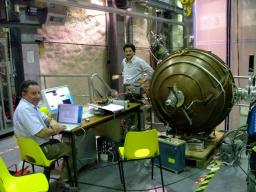Photograph of the spherical prototype in the MODANE laboratory
This large gas detector is based on a simple, strong and low-cost spherical geometry. The detector combines a large drift volume and proportional amplification in order to detect ionising particles. A metal ball at the centre of the sphere is held at a high voltage causing an avalanche effect in the gas surrounding it.
Target applications:
- Low energy neutrino physics
- industrial applications involving the detection of neutrons
The sphere was previously used as an accelerator cavity in the LEP. It consists of a spherical copper enclosure with a wall thickness of 6 mm and a diameter of 1.27 metres. The detector consists of a stainless steel ball with a radius of 8 mm held at a voltage of a few kilovolts. The actual voltage depends on the pressure and the required gain. The ion current drifts towards a charge amplifier, with the signal being passed to a computer via an analogue to digital converter. The sphere is a sealed detector filled with a suitable gas, in this case used as an active target. Tests have shown that the detector can operate for at least 2.5 months without refilling the gas and without any change in the gain or energy resolution of the detector.
The detector generates a radial field and the dependency is therefore 1/r2 1.The purpose of this field is twofold:
• To cause the electrons created during interactions with the gas to drift towards the detector.
To generate an avalanche effect in the 2 millimetre wide space surrounding the ball in order to amplify the signal.
Originally designed to study the oscillations of neutrinos or other properties such as their magnetic moment, or to detect neutrinos emitted during supernovae explosions, this new concept is today being considered for other potential applications.
With its excellent energy resolution, robustness and stability, it is capable of detecting minute quantities of radionuclides such as radon or 210Po with exceptional accuracy.
When filled with 3He 2 it becomes an effective neutron detector, capable of identifying very weak neutron sources.
This year, the detector was installed in the underground LSM laboratory in MODANE, with the aim of measuring very low neutron fluxes of the order of 10-6/cm 2/s and their energy spectra.
Initial measurements are yielding encouraging results. The rate of thermal neutrons has been determined accurately after taking data for two months under stable conditions. These initial investigations indicate that it should be possible to estimate the rate of fast neutrons. In order to measure fast neutrons accurately, a new sphere will have to be constructed using materials selected for low radioactivity and the quantity of 3He will need to be increased.
Author:
1 Dependence inversely proportional to the square of the radius of the ball.
2 He is very effective at capturing slow neutrons.


